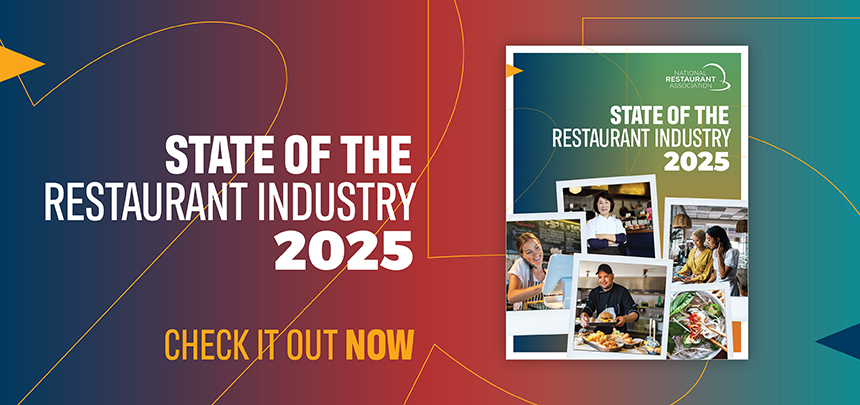Articles
February 06, 2025
The 2025 State of the Industry shows cautious optimism
New research finds operators feeling positive about business despite challenges they face.

Business in 2025 will remain highly competitive, but sales are expected to grow, the report finds.
With resilient consumer demand, the restaurant industry is expected to reach $1.5T in sales and employ 15.9M by year-end, according to the National Restaurant Association’s 2025 State of the Restaurant Industry report.
Findings indicate business in 2025 will remain highly competitive, but sales are expected to grow; more than 80% of operators believe sales will be higher or at least comparable to last year. Key to success: expanding customers’ perceived sense of “value” beyond pricing through hospitality and enhanced dining experiences, especially those that draw more on-premises business.
Learn more about the 2025 State of the Restaurant Industry at our Feb. 11 webinar
“Restaurants, particularly those in the fullservice category, are working to recapture pre-pandemic levels of on-premises traffic,” says Hudson Riehle, the Association’s SVP of Research & Knowledge. “Providing customers with higher perceived value and placing greater importance on the overall dining experience could positively affect sales. That includes emphasizing service and hospitality and providing an atmosphere that promotes socialization.”
Findings also show loyalty programs are more important than ever in influencing customers’ decisions about where to dine out.
“Pent-up demand for restaurant dining remains healthy,” he says. “However, higher food costs, labor costs, the threat of inflation, and increased competition—for guests and employees—continue to be big challenges. Nine out of 10 operators we talked to believe 2025 will be competitive with regards to on-premises dining, especially in the tableservice category, and demand for off-premises, takeout, and delivery meals will keep growing.”
The pent-up demand for dining out is different among different income strata, adds Chad Moutray, the Association’s VP of Research & Knowledge.
“There are Americans who are doing well and feeling flush,” he says. “They’re going out and spending, but others are trying to find ways to make ends meet, and that’s where the perception of value really resonates. The desire for value naturally crosses all income levels, but we’re seeing it more among those who have less disposable income to spend. As a result, for restaurateurs, the value component isn’t going to slow down. If anything, it will accelerate.”
Riehle says that value could show up as variable, or dynamic, pricing, which would allow restaurants to change prices of the same items depending on the day or time of day. That could help increase revenue, manage customer flow, and sell excess inventory. Operators might also increase happy hour offerings or place more emphasis on their loyalty programs.
“The fundamentals of the restaurant industry are strong, and operators are optimistic about the year ahead,” says Michelle Korsmo, President & CEO of the National Restaurant Association. “Industry sales are expected grow more than 4% this year, and employment should reach nearly 16M jobs. That growth will come from restaurant operators finding the balance of value and experience for consumers, and innovating breakthrough efficiency in their operations.”
Download the 2025 State of the Restaurant Industry report
Findings indicate business in 2025 will remain highly competitive, but sales are expected to grow; more than 80% of operators believe sales will be higher or at least comparable to last year. Key to success: expanding customers’ perceived sense of “value” beyond pricing through hospitality and enhanced dining experiences, especially those that draw more on-premises business.
Learn more about the 2025 State of the Restaurant Industry at our Feb. 11 webinar
“Restaurants, particularly those in the fullservice category, are working to recapture pre-pandemic levels of on-premises traffic,” says Hudson Riehle, the Association’s SVP of Research & Knowledge. “Providing customers with higher perceived value and placing greater importance on the overall dining experience could positively affect sales. That includes emphasizing service and hospitality and providing an atmosphere that promotes socialization.”
Findings also show loyalty programs are more important than ever in influencing customers’ decisions about where to dine out.
Restaurants essential to consumers’ lifestyles
The research, a compilation of sales projections and trends based on analysis and forecasts from Association economists, along with operator and consumer surveys, found consumers most definitely see restaurants as essential to their lifestyles, and prioritize spending on dining out over other things, like retail, Riehle notes.“Pent-up demand for restaurant dining remains healthy,” he says. “However, higher food costs, labor costs, the threat of inflation, and increased competition—for guests and employees—continue to be big challenges. Nine out of 10 operators we talked to believe 2025 will be competitive with regards to on-premises dining, especially in the tableservice category, and demand for off-premises, takeout, and delivery meals will keep growing.”
The pent-up demand for dining out is different among different income strata, adds Chad Moutray, the Association’s VP of Research & Knowledge.
“There are Americans who are doing well and feeling flush,” he says. “They’re going out and spending, but others are trying to find ways to make ends meet, and that’s where the perception of value really resonates. The desire for value naturally crosses all income levels, but we’re seeing it more among those who have less disposable income to spend. As a result, for restaurateurs, the value component isn’t going to slow down. If anything, it will accelerate.”
Riehle says that value could show up as variable, or dynamic, pricing, which would allow restaurants to change prices of the same items depending on the day or time of day. That could help increase revenue, manage customer flow, and sell excess inventory. Operators might also increase happy hour offerings or place more emphasis on their loyalty programs.
Report findings also tell us…
- Pent-up demand for restaurants is elevated across all restaurant occasions.
- The dining experience is more important than the price of the meal in drawing customers.
- 28% of operators plan to invest in technologies, such as Artificial Intelligence, to help improve efficiency, training, marketing, and off-premises operations.
- Customers would like more off-premises options, including number of restaurants from which to order. 51% of consumers say ordering for takeout or delivery is essential to their lifestyle.
- Boosting on-premises business is a focus for the majority of fullservice as well as limited-service operators.
- 77% of operators say recruiting and retaining employees is still a leading challenge, though they’re currently having better luck retaining employees; turnover is at its lowest rate in a decade.
- Some 4 in 10 employees in the workforce are teens or young adults, and operators report they’re most successful recruiting employees who are looking for part-time work and flexible schedules.
Challenges continue
Balancing elevated costs will continue in 2025. Food and labor costs, along with other expense categories, such as utilities, occupancy, supplies, insurance and credit-card processing fees, will continue to pressure the bottom line.“The fundamentals of the restaurant industry are strong, and operators are optimistic about the year ahead,” says Michelle Korsmo, President & CEO of the National Restaurant Association. “Industry sales are expected grow more than 4% this year, and employment should reach nearly 16M jobs. That growth will come from restaurant operators finding the balance of value and experience for consumers, and innovating breakthrough efficiency in their operations.”
Download the 2025 State of the Restaurant Industry report
Supported by
-
SageSage Intacct accounting software delivers exceptional customer experiences while driving revenue and growth. Built in the cloud for the cloud, Sage Intacct digitizes business processes, improving operational efficiency and profitability. Restaurant operators of all sizes depend on Sage Intact for exceptional visibility into their financial performance.Learn more
Get the report
Get the report
Sign up for our Newsletter
The latest news from the National Restaurant Association, published every other Thursday
By clicking Submit I agree to receive email communications from the National Restaurant Association and agree to our Privacy Policy(Opens in a new window).

